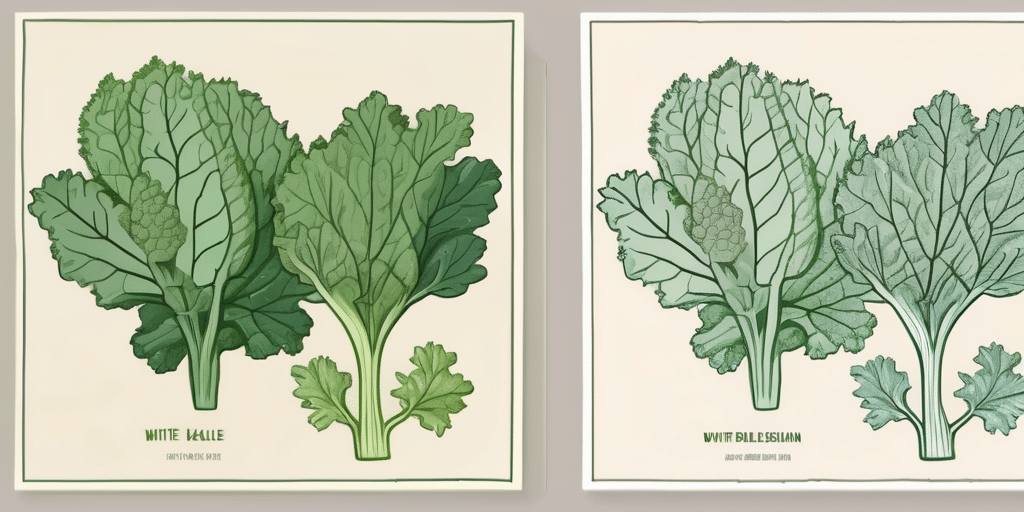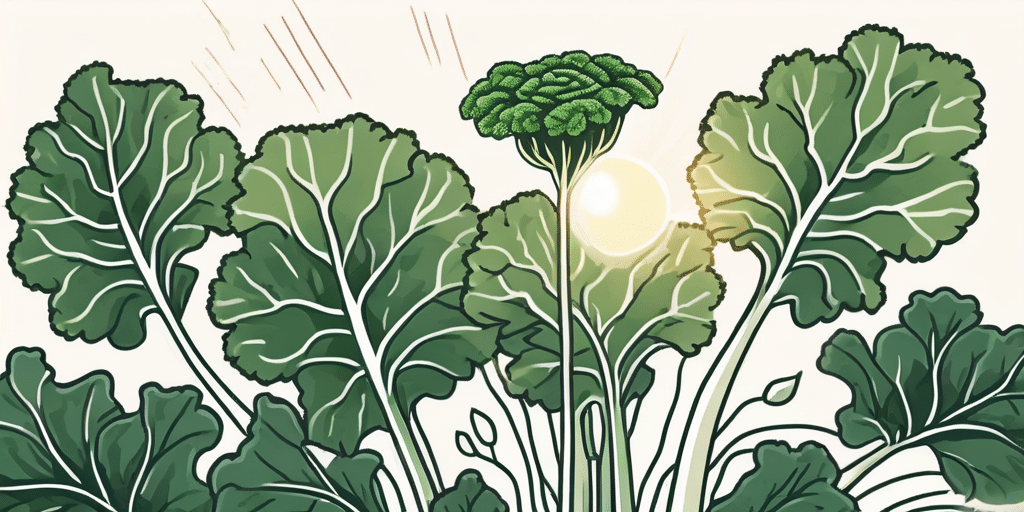In recent years, kale has gained immense popularity as a superfood, known for its nutrient-rich profile and numerous health benefits. Among the different varieties of kale available, two prominent ones are Red Ursa Kale and White Russian Kale. In this article, we will take a closer look at these two varieties and help you discover which one might be the right choice for you.
What is Red Ursa Kale?
Red Ursa Kale, scientifically known as Brassica oleracea var. acephala, is a striking kale variety with deep purple leaves and vibrant red veins. This visually appealing kale not only enhances the beauty of your garden but also adds a unique touch to salads and dishes. Red Ursa Kale is known for its rich anthocyanin content, an antioxidant that gives it its distinct color and offers potential health benefits.
Red Ursa Kale is a versatile vegetable that can be enjoyed in a variety of ways. Whether eaten raw in salads, sautéed with garlic and olive oil, or blended into smoothies for an added nutritional boost, this kale variety offers a range of culinary possibilities. Its slightly sweeter taste compared to other kale varieties makes it a favorite among those looking to incorporate more leafy greens into their diet.
Pros of Red Ursa Kale:
- High levels of anthocyanins, which have anti-inflammatory properties and may contribute to heart health
- Rich in vitamins A, C, and K, as well as minerals like calcium and iron
- Possesses a slightly sweeter taste compared to other kale varieties
- Can be grown in various climates, making it accessible to a wide range of gardeners
Red Ursa Kale’s vibrant color not only adds visual appeal to dishes but also indicates the presence of beneficial nutrients. The deep red and purple hues are a result of anthocyanins, which not only provide antioxidant properties but also offer potential anti-inflammatory benefits. Incorporating Red Ursa Kale into your diet can be a flavorful way to boost your intake of essential vitamins and minerals.
Cons of Red Ursa Kale:
- The strong flavor and slightly tougher texture may not appeal to everyone’s taste
- Anthocyanin levels may decrease when cooked
While Red Ursa Kale offers a range of health benefits, its strong flavor and slightly tougher texture may not be suitable for all palates. Some individuals may find the taste too assertive, especially when compared to milder greens. Additionally, it’s important to note that cooking Red Ursa Kale may lead to a reduction in anthocyanin levels, potentially impacting the overall antioxidant content of the vegetable. Finding the right balance between enjoying this kale variety raw and incorporating it into cooked dishes can help retain its nutritional value while catering to different taste preferences.
What is White Russian Kale?
White Russian Kale, also known as Brassica oleracea var. acephala, is an attractive kale variety with broad, curly, and bluish-green leaves. This variety is highly regarded for its milder taste and tender texture, which lends itself well to various culinary applications. White Russian Kale is packed with essential nutrients, making it a great addition to your diet.
White Russian Kale is not only delicious but also a nutritional powerhouse. It is rich in vitamins A, C, and K, providing a significant boost to your immune system and overall health. Additionally, this kale variety is a great source of folate, essential for cell growth and metabolism, and dietary fiber, which promotes digestive health.
Pros of White Russian Kale:
- Delicate and mild flavor, making it more palatable to those new to kale
- High in vitamins A, C, and K, folate, and dietary fiber
- A versatile ingredient that can be used in salads, soups, sautés, and smoothies
- Retains its vibrant green color even after cooking
White Russian Kale’s versatility in the kitchen is unmatched. You can enjoy it raw in salads for a refreshing crunch, or sauté it with garlic and olive oil for a simple yet flavorful side dish. Its tender leaves also make it a perfect addition to smoothies, adding a nutritional boost without compromising taste.
Cons of White Russian Kale:
- Lower anthocyanin content compared to Red Ursa Kale
- May not thrive in extremely hot climates
While White Russian Kale offers numerous benefits, it’s essential to note its lower anthocyanin content compared to other kale varieties like Red Ursa Kale. Anthocyanins are powerful antioxidants that contribute to the vibrant colors of fruits and vegetables, providing additional health benefits. Additionally, White Russian Kale may struggle to thrive in extremely hot climates, requiring adequate shade and water to prevent wilting.
Is Red Ursa Kale or White Russian Kale Right for You?
Choosing between Red Ursa Kale and White Russian Kale depends on your preferences and needs. If you are drawn to vibrant colors and are looking to maximize the anthocyanin content in your diet, Red Ursa Kale might be the ideal choice for you. However, if you prefer a milder flavor and a broader range of culinary options, White Russian Kale could be the better fit.
Regardless of your choice, both kale varieties offer exceptional nutritional value and can be incorporated into a well-balanced diet. Experimenting with different varieties allows you to enjoy the unique characteristics of each and to explore new flavors in your culinary endeavors.
Red Ursa Kale, with its deep red and purple hues, not only adds a pop of color to your dishes but also provides a higher level of antioxidants compared to its green counterparts. These antioxidants play a crucial role in reducing inflammation and promoting overall health. Incorporating Red Ursa Kale into your meals can help boost your immune system and protect your cells from damage.
On the other hand, White Russian Kale, also known as Siberian Kale, offers a more delicate flavor profile with slightly sweeter notes. This variety of kale is versatile in the kitchen and can be used in salads, smoothies, stir-fries, and soups. Its tender leaves make it a great option for raw preparations, allowing you to enjoy its fresh taste and nutritional benefits without overpowering other ingredients.
Frequently Asked Questions
- Can I grow Red Ursa Kale and White Russian Kale in my garden?
- What are the best ways to prepare Red Ursa Kale and White Russian Kale?
- Are there any potential allergenic reactions to Red Ursa Kale or White Russian Kale?
- Where can I buy Red Ursa Kale and White Russian Kale?
- Are there any specific cooking techniques that enhance the flavors of these kale varieties?
Yes, both Red Ursa Kale and White Russian Kale can be grown in various climates. They are hardy plants and can tolerate colder temperatures.
Both kale varieties can be enjoyed raw in salads, but they can also be sautéed, steamed, or used in soups and stews. Experimenting with different cooking methods will help you discover your preferred way of enjoying them.
Allergic reactions to kale are rare, but individuals with known allergies to cruciferous vegetables should exercise caution and consult with a healthcare professional if necessary.
Red Ursa Kale and White Russian Kale can often be found at local farmers’ markets, grocery stores, or specialty food stores. They are also available as seeds or seedlings for home gardening purposes.
Massaging kale leaves with a little bit of olive oil and salt can help soften them and reduce bitterness. Additionally, combining them with complementary ingredients like citrus fruits, nuts, and cheeses can further enhance their flavors.
Now armed with knowledge about Red Ursa Kale and White Russian Kale, you can confidently choose the kale variety that suits your taste preferences, culinary aspirations, and nutritional goals. Whether you decide to embrace the bold beauty of Red Ursa Kale or savor the delicate flavors of White Russian Kale, you can’t go wrong with this nutrient-packed superfood!
Join Our Green-Thumbed Community!
Ready to take your kale adventures to the next level? Subscribe for free to How to Grow Everything and learn how to build the garden of your dreams! With personalized gardening advice tailored to your location, grow zone, and experience level, you’ll have everything you need to grow Red Ursa Kale, White Russian Kale, and much more. Enjoy the best gardening tips, special offers, and insights delivered straight to your inbox—100% free. From our family to yours, let’s grow together!






